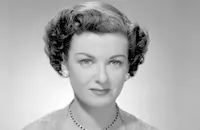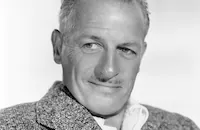The Macomber Affair

Brief Synopsis
Cast & Crew
Zoltan Korda
Gregory Peck
Joan Bennett
Robert Preston
Reginald Denny
Jean Gillie
Film Details
Technical Specs

Synopsis
A plane lands in Nairobi, Africa, carrying Margo Macomber, white hunter Robert Wilson, his African guides, and the dead body of Margo's husband, Francis. Police Captain Smollett asks Robert to fill out a homicide report, even though Robert insists that Francis' death--by a gunshot in the back--was an accident. Robert writes "accident" under Cause of Death in the report, but then throws it away, remembering the day he first met the Macombers: Francis, an excitable, boyish and wealthy American, who is hoping to prove his courage, hires Robert to take him hunting. Margo, whose marriage to Francis has deteriorated, is immediately taken with Robert's manly beauty and courage, and is unrelenting in her criticisms of her husband. The first night in camp, as Margo pretends to sleep, Francis promises her that, although they have quarrelled in the past, he has fallen in love with her again and wants to start over, but she does not respond. In the night, Francis is awakened by the roar of a lion a mile from camp, and in the morning, is determined to kill it. During the hunt, Francis shoots the lion, sending it into the brush to lick its wounds. Although Francis is afraid to complete the kill, Robert insists that a hunter cannot leave an animal to suffer, and leads Francis into the brush. When the lion charges, Francis runs, leaving Robert to kill the lion. Margo, furious at Francis' cowardice, greets him after the hunt with hostility, but kisses Robert on the lips in front of her husband. Later, Francis, feeling sorry for himself, beats an African servant, and Robert must intervene. The incident deepens Margo's animosity toward Francis, and that night, she visits Robert as Francis sleeps. He awakens, however, and finds her missing. The next day, Francis becomes exhilarated before the hunt. Although Margo tells him she hates him, he finds his courage at last and successfully shoots a buffalo. Robert congratulates Francis, then admits he is in love with Margo. After Francis and Robert shake hands, a wounded bull charges out of the brush in Margo's line of fire, and she shoots Francis in the back, killing him. Back in the present, Robert confronts Margo, who is scheduled to appear before a jury. She admits that, after years of tolerating Francis's cowardly brutality toward those weaker than he, she grew to hate him and became callous and cold. After she saw Francis and Robert shaking hands during the hunt, she knew that Francis was through with her. Finally, she confesses that if there is such a thing as "murder in the heart," then she murdered her husband. Robert then admits that he already noted in the police report that Francis' death was an accident, but forced her to confess so that he would know what kind of woman she is. Although Robert offers his support, Margo leaves to face the jury alone.

Director

Zoltan Korda
Cast

Gregory Peck

Joan Bennett

Robert Preston

Reginald Denny
Jean Gillie
Carl Harbord
Earl Smith
Frederic Worlock
Vernon Downing
Hassan Said
Martin Wilkins
Darby Jones
Crew
Frank Arnold
Seymour Bennett
Seymour Bennett
Benedict Bogeaus
Benedict Bogeaus
O. H. Borradaile
Jerry Bos
Joseph Depew
George Feld
Fred Francis
John Frederics
Charlotte Graham
Greta
Carley Harriman
Joseph I. Kane
Arthur M. Landau
William Lynch
Otis Malcolm
Erno Metzner
Meryl Reeves
Casey Robinson
Casey Robinson
Miklos Rosza
Karl Struss
Ken Walters
John D. Weiler
Jack Wheeler
Fred Widdowson
William H. Wilmarth

Videos
Movie Clip



Film Details
Technical Specs

Articles
The Macomber Affair
The 1947 drama The Macomber Affair stars Gregory Peck as Robert Wilson, a down-on-his-luck American big-game hunter in Nairobi hired to lead a rich American couple on a trophy hunt. As the film opens he's accompanying Margo Macomber (Joan Bennett) back from the savanna. Also on the plane is her husband's corpse. The story of their fateful safari spins out in flashback as the authorities push the stoic Robert for the details: the failing marriage and spiteful behavior beneath the façade of a happy vacation for Margo and husband Francis (Robert Preston), the growing attraction between Robert and Margo, the determination of Francis to find a renewed sense of strength and confidence on the hunt. Classic Hemingway themes and macho values played out on the author's favorite field of battle: man against nature.
In 1941, Samuel Goldwyn announced that he was making a film of the story with directors Howard Hawks and Victor Fleming and star Gary Cooper, to be shot in Africa. The film was never made, and a few years later producer-screenwriter Casey Robinson, a veteran of Captain Blood (1935), Dark Victory (1939), and Now, Voyager (1942), optioned the story with an eye toward Gregory in the lead. Robinson had brought Peck to Hollywood in 1943 for his first film, Days of Glory (1944), and the actor still owed him a picture. "I happened to love the story," Peck later recalled, and he took an active role in developing the film. He was "kind of an uncredited coproducer on the picture," in his own words. It was Peck who suggested Zoltan Korda, the Hungarian-born director of The Four Feathers (1939) and Sahara (1943), films with exotic locations and muscular action. Joan Bennett, a former ingénue whose career was getting a second act as a femme fatale in the films of Fritz Lang, was cast as the beautiful but bitter Margo. Robert Preston, a sturdy second lead in numerous films, had been absent from the screen since leaving Hollywood to serve in World War II. The role of Francis Macomber, a complex and complicated character, marked a welcome return to the movies.
The filmmakers sent a second unit to Africa to film scenes on the veldt but the actors never left North America. Instead, they found a location near Tecate, Mexico that had previously doubled for Africa in the early sound adventure Trader Horn and moved south for six weeks of shooting in the desert, matching shots of the actors firing into the distance with footage of wild animals on the African plains.
"He could be could be bad-tempered," Peck later said of director Korda, "but not to me; he liked me and I liked him. He was one of my favorite directors." Korda did not, however, like co-producer Benedict Bogeaus, a flashy Chicago real estate mogul turned independent producer. During a difficult scene, Bogeaus arrived on the set during to share his brainstorm. "I finally figured out what we should call the picture," he called out to the director, interrupting his concentration. "Congo!" According to biographer Michael Freedland, Korda pulled out his pocketknife, walked up to Bogeaus, and pressed the blade to his body. "You stupid son-of-a-bitch," he shouted. "You get off my set and if you ever come back here again I'll cut your liver out." According to Peck, he wasn't seen again.
While Hollywood was notorious for rewriting the books it brought the screen, Robinson had a reputation for honoring his source material. For The Macomber Affair he added the flashback structure and changed Wilson from British to American, but otherwise made very few changes to Hemingway's story. The Production Code censors, however, demanded changes to the ending to meet their requirements that characters be "punished" for their bad behavior. The filmmakers reached out to Hemingway to help them brainstorm an alternative that would satisfy the censors while preserving the author's sensibility, but Hemingway never responded. "We appealed to Hemingway to write the new ending himself," recalled Peck. "We appealed by letter, by telephone, by telegraph. Nothing! Total silence!" So the filmmakers came up with their own ending, which Peck later described as "the best and least compromising ending we could think of." But even while the ending was criticized, reviews were positive. It was "a brilliantly good job-the best yet-of bringing Hemingway to the screen," read the notice in Time magazine.
Peck returned to Hemingway five years later for The Snows of Kilimanjaro (1952), a glamorous Technicolor production co-starring Susan Hayward, Ava Gardner, and Hildegard Knef, but the more modest The Macomber Affair, independently produced in black-and-white, is still considered the superior adaptation.
Bibliography The Bennett Playbill, Joan Bennett and Lois Kibbee. Holt, Rinehart and Winston, 1970.
Gregory Peck, Michael Freedland. Morrow, 1980.
Gregory Peck: A Biography, Gary Fishgall. Scribner, 2002.
Gregory Peck: A Charmed Life, Lynn Haney. Carroll & Graf Publishers, 2003.

The Macomber Affair
Quotes
Trivia
Notes
The opening title card of the film reads: "Ernest Hemingway's The Macomber Affair." The film's working titles were The Great White Hunter and The Short Happy Life of Francis Macomber. The character portrayed by Gregory Peck was based on real-life hunter Bror Blixen, whose wife, Isak Dinesen (1885-1962), was the author of the autobiographical book Out of Africa. In the 1985 film adaptation of the book, also titled Out of Africa, Blixen's character was portrayed by Klaus Maria Brandauer. In August 1941 Hollywood Reporter announced that Samuel Goldwyn was planning a film based on Hemingway's short story, which was to be co-directed by Howard Hawks and Victor Fleming and star Gary Cooper. Goldwyn, Hawks, Fleming and Cooper were all to produce the picture, and filming was to be done in Africa. That film was never made, however. Modern sources state that Hemingway received $75,000 from Casey Robinson, one of the writers of the 1947 film, for the screen rights to his story. The film marked Robert Preston's return to the screen after four years in the Army Air Force. According to contemporary sources, wild animal safari scenes in the film were photographed in Kenya, Africa, while location shooting with the cast took place near Tecate, Mexico.
Many modern sources have called the film one of the most faithful cinematic adaptations of a Hemingway story, despite the fact that the story's ending was significantly altered. In Hemingway's story, "Margo" and "Wilson" do have a sexual affair, but do not fall in love, and Margo remains a less sympathetic character at the end of the novel. According to files in the MPAA/PCA Collection at the AMPAS Library, after the Breen Office objected to any indication of a happy ending for the "two wrongdoers," Wilson and Margo, a new ending was written in which Margo goes before the coroner's office and awaits a verdict. In the final version of the film, Margo's guilt remains ambiguous, and ads for the film contained the slogan "Murder or Accident?" The Breen office also ordered that the filmmakers "more clearly indicate the seriousness of Wilson's punishment for his part in the adultery." As a result of the PCA order, Wilson is shown losing his license. The New York Times review criticized the film for turning Hemingway's story into a romance, stating: "It is plainly a sentimental fixture which has no place in the film and which detracts from an otherwise commendable hate-and-jealousy yarn. If the footage devoted to this tag-end had been used to emphasize the irony of the story-of humans, so-called, slaughtering splendid beasts...-the boys would have had quite a film."
Before the film was issued a Code Seal, the hunting scenes had to be approved by the American Humane Society. In a letter from Richard C. Craven of the Humane Society to MPAA agent Geoffrey Shurlock, Craven states that, although he personally "abhor[red] hunting," he could not protest the film because the kill was restricted to one lion and two buffalo and was photographed by cameramen from Great Britain, where hunting is accepted "as little to worry about."














